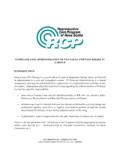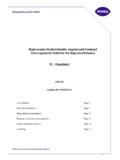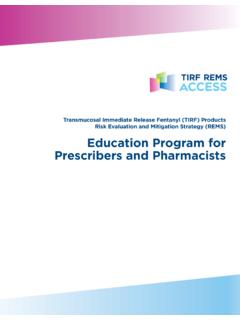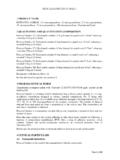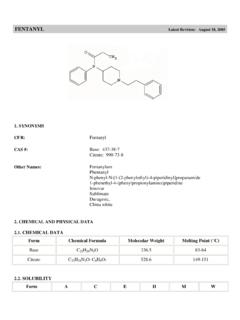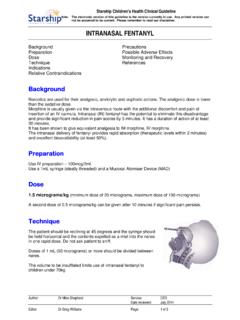Transcription of Fentanyl and its analogues - 50 years on
1 GLOBAL. 17. VOLUME March S MART. UPDATE. Fentanyl and its analogues - 50 years on Research 2017. GLOBAL. SMART. UPDATE. About the SMART Update Content Synthetic drugs constitute one of the most significant SPECIAL SEGMENT 3. drug problems worldwide. After cannabis, amphet- amine-type stimulants (ATS) are the second most widely used drugs across the globe, with use levels SHORT SEGMENTS 8. often exceeding those of heroin and/or cocaine. Along with ATS, the continued growth of the new psychoactive BEIJING, China September 2015 8. substances (NPS) market over the last years has become BEIJING, China May 2015 8. a policy challenge and a major international concern. A growing interplay between these new drugs and tra- TOKYO, Japan August 2016 8. ditional illicit drug markets is being observed. By July 2016, the emergence of NPS had been reported from HELSINKI, Finland June 2015 8. 102 countries and territories. Trends on the synthetic drug market evolve quickly each year.
2 STOCKHOLM, Sweden August 2016 9. The UNODC Global Synthetics Monitoring: Analyses, Reporting and Trends (SMART) Programme enhances TALLINN, Estonia July 2016 9. the capacity of Member States in priority regions to generate, manage, analyse, report and use synthetic VIENNA, Austria May 2016 9. drug information to design effective policy and pro- VIENNA, Austria November 2016 9. gramme interventions. Launched in September 2008, the Global SMART Programme provides capacity building GENEVA, Switzerland November 2016 10. to laboratory personnel, law enforcement and research officers in the Pacific, East and South-East Asia, South BRUSSELS, Belgium 2015 10. Asia, the Near and Middle East, Africa and Latin America;. and regularly reviews the global amphetamine-type DUBLIN, Ireland 2016 10. stimulants and new psychoactive substances situation. Its main products include online drug data collection, S O PAULO, Brazil September 2016 10. situation reports, regional assessments and the UNODC.
3 Early Warning Advisory (EWA) on new psychoactive OTTAWA, Canada September 2016 11. substances. The EWA is a webportal that offers regu- lar updates on new psychoactive substances, including LOS ANGELES, California March 2016 11. trend data on emergence and persistence, chemical data, supporting documentation on laboratory analysis BRITISH COLUMBIA, Canada June 2016 11. and national legislative responses (available at: www. WASHINGTON , United States 2016 11. ). The Global SMART Update (GSU) series is published twice a year in English, Spanish and Russian and provides information on emerging patterns and trends of the global synthetic drug situation in a concise format. Each issue of the Global SMART Update contains a special segment and short segments on the topic of interest.*. Electronic copies of the Global SMART Updates and other publications are available at: unodc/en/ Past issues have covered topics such as UNGASS 2016 recommenda- tions, injecting use of synthetic drugs, legal responses to NPS, key facts about synthetic cannabinoids and regional patterns of methamphetamine manufacture.
4 * The information and data contained within this report are from official Government reports, press releases, scientific journals or incidents confirmed by UNODC Field Offices. An asterisk (*) indicates that information is preliminary as it stems from open sources' where UNODC is waiting for official confir- mation. This report has not been formally edited. The contents of this publication do not necessarily reflect the views or policies of UNODC or contributory organizations and neither do they imply any endorsement. Suggested citation: UNODC, Global SMART Update Volume 17, March 2017. 2. Volume 17. Fentanyl and its analogues - 50 years on SPECIAL SEGMENT. ABSTRACT Fentanyl is the strongest opioid available for medical use in humans, Fentanyl and its analogues are potent synthetic opioids, which are with about 100 times the potency of liable to abuse. They are often sold under the guise of heroin or morphine2. It is highly valued for its prescription medicines, such as oxycodone, and this exacerbates analgesic and sedative effects and the risk of overdose and associated fatalities.
5 An increasing num- widely used in the management of ber of deaths have been associated with the use of Fentanyl and severe pain and in anaesthesia. The its analogues , particularly in North America. The facile synthesis of three Fentanyl analogues approved a number of these substances, coupled with the ease in obtaining for pharmaceutical use, sufentanil, alfentanil and remifentanil, have the required precursor chemicals and equipment, has led to an very short onset and duration of increase in clandestine manufacture. action, and their medical use is lim- ited to intravenous anaesthesia3. Introduction Carfentanil, estimated to be about 10,000 times more potent than Recent years have seen a sharp rise and Fentanyl analogues . Evidence on morphine4, is intended only for vet- in opioid-related overdose deaths fatalities associated with emerging erinary use on large animals, and not mainly in North America, and to a Fentanyl analogues is accumulating, approved for medical use in humans.
6 Certain extent, in Europe. While the also, in other regions of the world. challenge posed by these fatalities The pills and powders containing The liability of Fentanyl and its is complex, more evidence is emerg- such substances sold on the illicit analogues to abuse and the depen- ing about the role Fentanyl and its market pose a threat to public health dence-potential are reflected in the analogues play in the current crisis. because of the variable quantity and international legislative responses. Fentanyl itself is a powerful opioid potency of the active components, Fentanyl was first synthesized in analgesic, with an established place which in extreme cases, such as with 1959, and was placed under inter- carfentanil, may be 10,000 times national control as a Schedule 1. in medicine. Yet, there has always more potent than morphine. Such substance in 1964 under the Single been concern about its potential for products can prove particularly dan- Convention on Narcotic Drugs of abuse and dependence, and it was gerous when sold as street heroin, 1961.
7 During the ensuing decades, therefore placed under international together with heroin or as counter- the list of scheduled substances control as far back as 1964. In the has grown to include all Fentanyl 1970s and 1980s, products con- feit prescription drugs, without the user's knowledge. analogues approved for human taining Fentanyl and its analogues medical use (sufentanil in 1980, appeared on the illicit drug market, This publication aims to inform alfentanil in 1984, and remifentanil and became notorious for accidental about the growing complexity of the in 1999), and several analogues The problem seems to opioid market, in particular the fen- which have not been developed have resurfaced and the clandes- tanyl group, international controls, into pharmaceutical products tine manufacturing of Fentanyl has evolving patterns of use and associ- (acetyl-alpha- methylfentanyl, alpha- risen to unprecedented levels. The ated risks, global developments in methylfentanyl and 3-methylfentanyl required materials and equipment manufacture and trafficking of fen- were placed under international for manufacture are readily available tanyl analogues and their precursors.)
8 Control in 1988, and alpha-methyl- online, at low cost. This situation is thiofentanyl, beta-hydroxyfentanyl, aggravated by the rapid emergence Good medicines, beta-hydroxy-3-methylfentanyl, of novel Fentanyl analogues which bad drugs? 3-methylthiofentanyl, para-fluoro- have not been approved for medi- Fentanyl belongs to a class of potent Fentanyl and thiofentanyl in 1990). cal use. opioid analgesics, the 4-anilidopi- North America is particularly affected peridines. These synthetic opioids by an opioid overdose crisis. While have a high affinity for the -opioid originally, the sharp rise in over- receptor, which presents both bene- doses was attributed to heroin, the fits and drawbacks. On the one hand, current crisis is mainly attributed to strong -opioid receptor agonists 2 Chodoff P, Domino EF. Comparative phar- macology of drugs used in neuroleptanalge- clandestinely manufactured Fentanyl from the Fentanyl family have excel- sia. Anesthesia and Analgesia, 44 (5) (1965), lent pain-relieving properties.
9 On the pp. 558 563. other hand, such drugs are liable to 3 Lemmens H. Pharmacokinetic-pharmaco- abuse and have high dependence- dynamic relationships for opioids in bal- anced anaesthesia. Clin Pharmacokinet. producing properties. 1995;29:231 242. 1 Henderson GL. Fentanyl -related deaths: demographics, circumstances, and toxicology 4 Janssen PA. Potent, new analgesics, tailor- of 112 cases. Journal of Forensic Science. made for different purposes. Acta Anaesthe- 1991 Mar 1;36(2):422-33. siol Scand. 1982 Jun;26(3):262-8. 3. GLOBAL. SMART. UPDATE. Figure 1: International control of Fentanyl and its analogues , 1964-2016. Fentanyl analogues reported to the UNODC Early Warning Advisory acrylfentanyl, para- uoroisobutyrfentanyl 2016. butyrfentanyl, furanylfentanyl 2015 acetylfentanyl acetylfentanyl, ocfentanil 2013. remifentanil 1999. 1990. 1988. alpha-methyl-thiofentanyl, beta-hydroxyfentanyl, beta-hydroxy-3-methylfentanyl, 3-methylthiofentanyl, para- uorofentanyl, thiofentanyl 1984.
10 Alfentanil acetyl-alpha-methylfentanyl, alpha-methylfentanyl, 3-methylfentanyl 1980. sufentanil 1964 Fentanyl and analogues controlled under the Fentanyl 1961 Single Convention on Narcotic Drugs Acetylfentanyl was placed under These substances were described in Nonmedical use of Fentanyl and its international control in 2016, while scientific literature but never devel- analogues can have severe health butyrfentanyl has been recom- oped into pharmaceutical products. consequences. Tolerance and depen- mended for control by the WHO5. Examples include acetylfentanyl, dence develop very fast, and may Carfentanil, which was first synthe- butyrfentanyl, furanylfentanyl, reach extreme levels. Above all, each sized in 1974 and remains the most and ocfentanil. Other substances episode of nonmedical use carries a potent commercially available opioid currently present in the illicit opioid high risk of overdose and death as in the world, is not under interna- market are newly designed Fentanyl a result of respiratory depression tional control.










